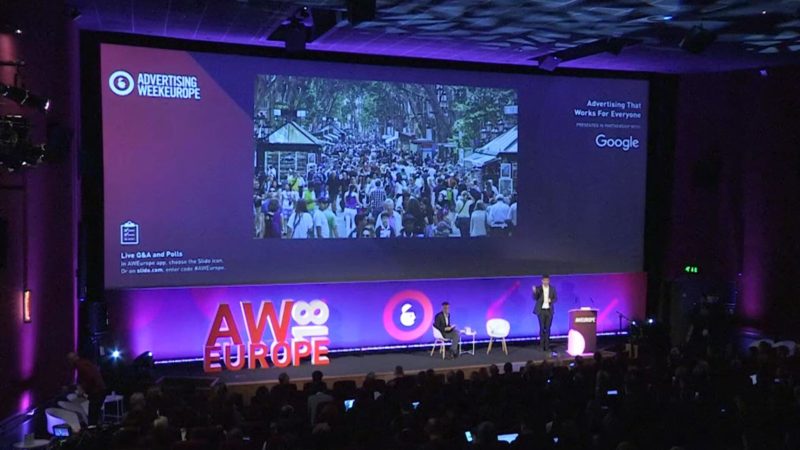Google announces third-party measurement expansions with MRC, Nielsen, comScore
Executives discussed ways the company is addressing calls for greater measurement, verification and brand safety control, as well as GDPR.

Google’s Matt Brittin and Sridhar Ramaswamy at Advertising Week Europe 2018
Google’s SVP of Ads and Commerce Sridhar Ramaswamy and Matt Brittin, Google’s EMEA president, acknowledged it’s been a hard year with concerns around security, transparency and privacy reaching new levels of urgency. They stressed the ways the company has been listening and responding to issues raised by users, advertisers and publishers — and touched on GDPR readiness.
“We face some fairly fundamental issues in how we think about users, content, advertising,” said Ramaswamy in an address at Advertising Week Europe in London on Wednesday morning, pledging to “actively engage with all stakeholders more proactively and act more aggressively to fix problems and make things better.”
For advertisers, Brittin and Ramaswamy highlighted three areas of focus:
- Brand safety assurances and controls.
- Verification that traffic on ads is real.
- That advertisers get fair value for their advertising.
Advertisers have loudly demanded third-party measurement and verification and improved brand safety controls over the past year. The executives said they have listened and have been taking action. Today, they announced new measurement and brand safety efforts and touched on how current features will apply to GDPR.
Third-party measurement updates
“It is clear that there is a strong need for commonly accepted standards by which advertising can be measured,” Ramaswamy told the audience. “It’s also clear to all of us that these metrics need to be verified by third parties and measured by third parties.”
He said Google already supports 30 Media Ratings Council (MRC) standards for clicks, impressions, viewability and more across devices. Ramaswamy announced that the company is currently working on getting certification for 40 additional MRC metrics, some in collaboration with third parties such as Integral Ad Science, Moat and DoubleVerify. Google first announced it was opening up to MRC auditing in March 2017.
Google is also expanding YouTube reach measurement from Nielsen and comScore. Nielsen mobile measurement on YouTube is extending to three new countries: the UK, Germany and France.
Finally, it is expanding comScore measurement for YouTube to nearly 13 countries.
To help advertisers compare YouTube advertising to TV campaign performance, Ramasamy announced a new partnership with German TV ratings measurement group AGF. That effort will launch later this year with other plans for groups in other markets in development. AGF has included reach data from YouTube in its figures since 2015.
On transparency and brand safety for advertisers
“It was clear to us that we had problems at a platform level on YouTube with content that just shouldn’t have been there,” Ramaswamy said of the advertiser backlash over ads appearing next to objectionable and extremist videos.
He reiterated previously announced initiatives and said the company is on track to hire the more than 10,000 manual content reviewers it pledged to add.
Manually vetting of all content on Google Preferred, the top 5 percent of channels on YouTube, is now complete in the UK, Ramaswamy announced.
“As part of brand safety in YouTube, all of you also said, we need independent standards and independent verification of these standards,” said Ramaswamy. “So we are very pleased we are now conforming with the [brand safety] standard put forward by JICWEBS [the Joint Industry Committee for Web Standards in the UK and Ireland].”
Ramaswamy added that advertisers have indicated the brand safety controls within YouTube are too complicated and that the company is in the process of simplifying controls for advertisers to choose what types of content they want their ads to appear against.
On GDPR
Transparency and privacy are even more top of mind in Europe as the General Data Protection Regulation (GDPR) deadline of May 25 approaches.
“We are working hard on [GDPR] as well,” said Ramaswamy, while noting that capabilities such as enabling users to extract data and take it to a rival service and see and adjust the data Google is using for targeting ads to them in My Account “are all things that help us as GDPR approaches.”
GDPR adds teeth to existing data regulations in the EU. The regulation also applies to all companies that process personal data of EU citizens, regardless of where the EU citizen resides. (To learn more, see our GDPR guide on Marketing Land’s sister site, MarTech Today.)
Ramaswamy said Google would have more to say about what it’s doing to be ready for GDPR in the coming days and weeks.
Contributing authors are invited to create content for MarTech and are chosen for their expertise and contribution to the martech community. Our contributors work under the oversight of the editorial staff and contributions are checked for quality and relevance to our readers. MarTech is owned by Semrush. Contributor was not asked to make any direct or indirect mentions of Semrush. The opinions they express are their own.
Related stories